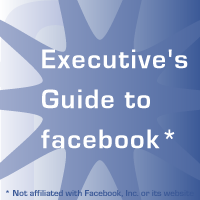By Christopher Rollyson Comparing Facebook, LinkedIn and Twitter for Developing Business Relationships offers Quick Thoughts on How Facebook Compares to LinkedIn and Twitter
 Business executives like to put Facebook, LinkedIn and other platforms in the same category with each other, “social networks,” and they often ask me which one is “best.” This approach is normal when considering an emerging phenom like Web 2.0 venues, but it is not the right way to think: although Facebook, LinkedIn, Twitter and others all enable your company to engage your stakeholders, each venue is so distinct and the techniques of engagement so different, that they do not allow an apples to apples comparison. That said, here I will describe each platform’s uniqueness and suggest how you can use it to develop business relationships. Business executives like to put Facebook, LinkedIn and other platforms in the same category with each other, “social networks,” and they often ask me which one is “best.” This approach is normal when considering an emerging phenom like Web 2.0 venues, but it is not the right way to think: although Facebook, LinkedIn, Twitter and others all enable your company to engage your stakeholders, each venue is so distinct and the techniques of engagement so different, that they do not allow an apples to apples comparison. That said, here I will describe each platform’s uniqueness and suggest how you can use it to develop business relationships.
Adding to the confusion, Facebook has a LinkedIn Group, and LinkedIn has Facebook and Twitter groups. I encourage you to spend some time there if you are interested in how they can work together. Here I’ll present my back-of-the-envelope thoughts, and I encourage you to share yours in comments.
Continue reading Comparing Facebook, LinkedIn and Twitter for Developing Business Relationships
By Christopher Rollyson The Power of Emergent Organization
 Facebook and MySpace have distinct strategies for global expansion that hold crucial lessons for executives. Facebook is following a quintessentially Web 2.0 strategy while MySpace is pursuing a more traditional publishing model that most mature businesses will recognize. The results, although somewhat preliminary, clearly show the relative advantages to Facebook’s approach, so here I’ll offer a brief description of the two and suggest learnings that you might apply to your business. Facebook and MySpace have distinct strategies for global expansion that hold crucial lessons for executives. Facebook is following a quintessentially Web 2.0 strategy while MySpace is pursuing a more traditional publishing model that most mature businesses will recognize. The results, although somewhat preliminary, clearly show the relative advantages to Facebook’s approach, so here I’ll offer a brief description of the two and suggest learnings that you might apply to your business.
By Christopher Rollyson  As I predicted in Web 2.0 Adoption Curve, 2009-2015, a media backlash against social networks is beginning because most people do not know how to use the networks effectively nor how to integrate their activity on social networks with their other activities. The use of social networks is in its infancy and is easy to criticize. As I predicted in Web 2.0 Adoption Curve, 2009-2015, a media backlash against social networks is beginning because most people do not know how to use the networks effectively nor how to integrate their activity on social networks with their other activities. The use of social networks is in its infancy and is easy to criticize.
Last week, I took the New York Times’ Facebook Exodus to task as an exceptionally lame example, and here I’ll offer a briefer treatment of a Wall Street Journal article, How Facebook Can Ruin Relationships. Unfortunately, but very predictably, the journalists and editors that are responsible for these articles are not terribly knowledgeable about social networks. Take this into account when reading.
This backlash will discredit social networks in the short term, and you can use this to your advantage by continuing to use them in your business while others are napping. Social networks will remake society because they change the economics of communication and relationships. Those who use them will create a significant advantage for themselves.
By Christopher Rollyson  The end of a year and a decade seems an appropriate time to go on the record about something I have felt for a long time: Twitter will prove to be one of the most disruptive and transformational Web 2.0 innovations of the decade. Although I am an experienced user myself and have advised clients on using Twitter, I perceive that there is much more that remains to be discovered, a considerable well of untapped je ne sais quoi. That is a hallmark of transformative innovations, for they challenge ways of thinking, they push once-cherished assumptions out the door. Here I will outline the significance of Twitter’s key features and suggest why you might want to use it to create rare value for yourself and your company. The end of a year and a decade seems an appropriate time to go on the record about something I have felt for a long time: Twitter will prove to be one of the most disruptive and transformational Web 2.0 innovations of the decade. Although I am an experienced user myself and have advised clients on using Twitter, I perceive that there is much more that remains to be discovered, a considerable well of untapped je ne sais quoi. That is a hallmark of transformative innovations, for they challenge ways of thinking, they push once-cherished assumptions out the door. Here I will outline the significance of Twitter’s key features and suggest why you might want to use it to create rare value for yourself and your company.
By Christopher Rollyson  The baby is born!.. After struggling to get the last member of the triad out of the gate, we’re finally here. In 2009, have been working with executives around the US to use Facebook for their businesses and personally, and the Executive’s Guide to Facebook will share vital information to help you understand it and create business value. In 2010, expect to see: The baby is born!.. After struggling to get the last member of the triad out of the gate, we’re finally here. In 2009, have been working with executives around the US to use Facebook for their businesses and personally, and the Executive’s Guide to Facebook will share vital information to help you understand it and create business value. In 2010, expect to see:
- Practical guides for using Facebook for business
- Strategic, breakthrough insights for using Facebook to create better business relationships more quickly
- How to launch and use Facebook Pages, Groups and other features
- Strategy and tactics for using Facebook advertising
- Analyses of misleading media coverage of Facebook
- Select coverage of Facebook as a company
I invite you to respond in comments with items on your wishlist!
By Christopher Rollyson Watch out for This Web 2.0 Transformation Driver
 Web 2.0 sites provide rich functionality and interactivity, but these have come with a significant tax: users need to create credentials and profiles in order to log in to each site, and this is frustrating and reduces interactivity. Users think, “Why can’t we just have one login!?” (i.e.,”single sign-on” or “federated identity”). In 2009, Facebook launched Facebook Connect (FC) while Google offered Google Friendconnect (GFC) which are significant steps toward Web 2.0 single sign-on—with some interesting wrinkles. Web 2.0 sites provide rich functionality and interactivity, but these have come with a significant tax: users need to create credentials and profiles in order to log in to each site, and this is frustrating and reduces interactivity. Users think, “Why can’t we just have one login!?” (i.e.,”single sign-on” or “federated identity”). In 2009, Facebook launched Facebook Connect (FC) while Google offered Google Friendconnect (GFC) which are significant steps toward Web 2.0 single sign-on—with some interesting wrinkles.
 At some levels, FC and GFC are quite similar, but they are starkly different in other ways. However, these offerings are one of the most important Web 2.0 milestones of 2009, and here I’ll discuss their far-reaching implications for businesses and people. As I will argue, they are major transformation drivers in the next phase of Web 2.0 maturity, and they offer individuals and companies exciting new opportunities and threats. At some levels, FC and GFC are quite similar, but they are starkly different in other ways. However, these offerings are one of the most important Web 2.0 milestones of 2009, and here I’ll discuss their far-reaching implications for businesses and people. As I will argue, they are major transformation drivers in the next phase of Web 2.0 maturity, and they offer individuals and companies exciting new opportunities and threats.
By Christopher Rollyson  Decoding Evolutionary Roots of Human Social Behavior is a review and analysis of Grooming, Gossip, and the Evolution of Language (and the human brain). Having been immersed in experiential social media since 2006, I’ve increasingly turned to evolutionary psychology to understand human behavior at a much deeper level: by studying primates, I get much closer to the root causes of human behavior, and this book was my introduction to the field. Decoding Evolutionary Roots of Human Social Behavior is a review and analysis of Grooming, Gossip, and the Evolution of Language (and the human brain). Having been immersed in experiential social media since 2006, I’ve increasingly turned to evolutionary psychology to understand human behavior at a much deeper level: by studying primates, I get much closer to the root causes of human behavior, and this book was my introduction to the field.
Inside Human OS—The Roots of Facebook Behavior Revealed by Primate Professor
Digital social networks give their members front row seats in many aspects of human dramas, but few companies or individuals have the understanding of human behavior to appreciate fully what they are seeing. Many executives of commercial and government enterprises perceive “social” behavior as frivolous and discourage employees’ activity in social networks. This exceptional book shows that the Industrial Economy idea of the separation of “work” and “social” is dangerously out of place in the Knowledge Economy, in which collaboration among people produces the lion’s share of business value. To succeed in the Knowledge Economy, leaders need to appreciate the importance of social activity in collaboration and productivity, and how digital social networks can increase productivity. In this review, I will try to do the book justice, but I will also attempt to show how its ideas apply to digital social networks, collaboration and productivity.
To use a technical metaphor, Windows has its DOS, and Mac OS X has its UNIX. In fact, Windows and Mac OS X are just interfaces that come between the core engine (DOS and UNIX) of the computer and the user, so s/he doesn’t have to have technical knowledge to run the machine. However, at critical moments, it can be very advantageous to understand certain aspects of the core operating systems. Since understanding human behavior is critical to success in virtually all human endeavors, it might be useful to understand what I’ll term as “Human OS.” This enthralling book gets way under the covers on “social” network behavior and puts it all into perspective. As such, readers come to appreciate how and why people behave the way they do.
By Christopher Rollyson  Ironically Self-contradictory Article Overlooks the Real Purpose of Digital Social Networks Ironically Self-contradictory Article Overlooks the Real Purpose of Digital Social Networks
Wednesday, the Wall Street Journal published What Facebook Can’t Give You, which chronicles the growth of the “Wednesday 10,” a professional networking group started in 1957 in Manhattan by William Safire. Established when members were in their 20s, the Wednesday 10 saw many of its members go on to become leading broadcasting executives, investment bankers and real estate moguls, and the point of the headlines is that “old fashioned” offline face to face networking is superior to online social networking.
This is another example of uninformed “criticism” of online social networks because it takes a mutually exclusive attitude toward offline and online social networking, a growing head-in-the-sand response to the disruption that the latter presents. Read on for a short review and discussion of how successful executives in the 21st century will use all modes of social networking to increase competitiveness through authentic relationships.
By Christopher Rollyson  A professional friend and marketer just posed a very interesting question: doesn’t Twitter make it easier for competitors to poach customers? Citing this post, she asked: “Isn’t it dangerous to display your customer relationships in social networks because competitors will ‘steal’ your customer list?” Thanks to her, I’ll take this opportunity to explain the issues behind the question and how to increase transparency without compromising competitiveness in your business. A professional friend and marketer just posed a very interesting question: doesn’t Twitter make it easier for competitors to poach customers? Citing this post, she asked: “Isn’t it dangerous to display your customer relationships in social networks because competitors will ‘steal’ your customer list?” Thanks to her, I’ll take this opportunity to explain the issues behind the question and how to increase transparency without compromising competitiveness in your business.
Continue reading Increasing Customer Transparency: Real Threat or a Paper Tiger for Marketers?
By Christopher Rollyson  Last week I had a call with a stellar product-focused company that was interested in using social networking to increase engagement. I introduced the idea of evolving the conversation past the product because I observe that most product- and service-focused companies will face the fact that very few customers love their products or services as much as they do (see Market Advisory on Consumer Empowerment). Customers want to accomplish something by using said product or service. When it comes to encouraging persistent conversations, most companies will have better success by engaging at the experience level, not only at the product level. Here I’ll present some examples of companies that are doing this right and insights into why the programs are working. Last week I had a call with a stellar product-focused company that was interested in using social networking to increase engagement. I introduced the idea of evolving the conversation past the product because I observe that most product- and service-focused companies will face the fact that very few customers love their products or services as much as they do (see Market Advisory on Consumer Empowerment). Customers want to accomplish something by using said product or service. When it comes to encouraging persistent conversations, most companies will have better success by engaging at the experience level, not only at the product level. Here I’ll present some examples of companies that are doing this right and insights into why the programs are working.
|
|
 Business executives like to put Facebook, LinkedIn and other platforms in the same category with each other, “social networks,” and they often ask me which one is “best.” This approach is normal when considering an emerging phenom like Web 2.0 venues, but it is not the right way to think: although Facebook, LinkedIn, Twitter and others all enable your company to engage your stakeholders, each venue is so distinct and the techniques of engagement so different, that they do not allow an apples to apples comparison. That said, here I will describe each platform’s uniqueness and suggest how you can use it to develop business relationships.
Business executives like to put Facebook, LinkedIn and other platforms in the same category with each other, “social networks,” and they often ask me which one is “best.” This approach is normal when considering an emerging phenom like Web 2.0 venues, but it is not the right way to think: although Facebook, LinkedIn, Twitter and others all enable your company to engage your stakeholders, each venue is so distinct and the techniques of engagement so different, that they do not allow an apples to apples comparison. That said, here I will describe each platform’s uniqueness and suggest how you can use it to develop business relationships.





